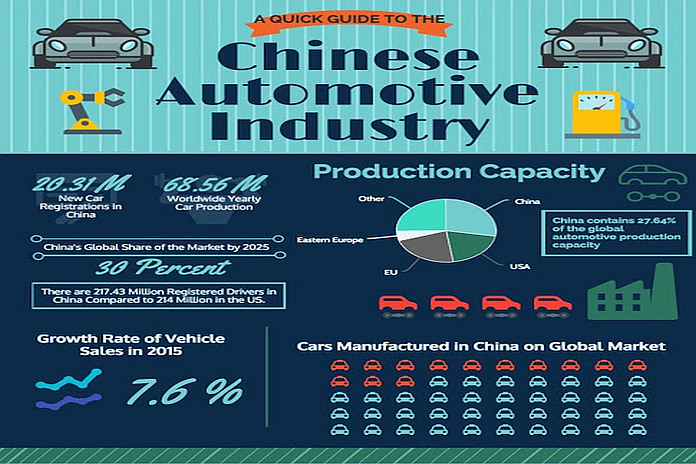The Chinese Automotive Market: A Deep Dive Into The Challenges Faced By BMW And Porsche

Table of Contents
Intense Domestic Competition
The rise of domestic Chinese automakers represents a significant challenge to established foreign brands like BMW and Porsche. These brands are no longer facing a solely price-driven market; they're now competing against technologically advanced and increasingly sophisticated domestic rivals.
Rise of Domestic Brands
The success of Chinese brands such as BYD, Nio, and Xpeng is undeniable. They're not just offering cheaper alternatives; they're presenting strong competition across various segments.
- Superior technology integration in electric vehicles (EVs): Domestic brands are often at the forefront of EV technology, incorporating cutting-edge battery technology, advanced driver-assistance systems (ADAS), and innovative connectivity features.
- Aggressive pricing strategies targeting price-sensitive consumers: Chinese brands often offer highly competitive pricing, leveraging economies of scale and government support to undercut foreign competitors. This is particularly effective in a market where price sensitivity is a major factor.
- Strong brand loyalty among Chinese consumers towards domestic brands: A rising sense of national pride and trust in domestically produced goods is fostering strong brand loyalty towards Chinese automakers. This presents a significant hurdle for foreign brands to overcome.
Technological Innovation
Chinese brands are rapidly advancing in areas like autonomous driving and connected car technologies. This technological leap is fueled by substantial investments and supportive government policies.
- Investment in R&D by Chinese automakers surpassing that of some foreign competitors: Many Chinese automakers are investing heavily in research and development, leading to rapid advancements in technology and innovation.
- Government support and subsidies for domestic EV development: Government policies and subsidies heavily favor the development and adoption of electric vehicles by domestic brands, further strengthening their competitive position.
- Focus on smart features and digital integration in Chinese-made vehicles: Chinese consumers highly value technological features and digital integration, an area where domestic brands are often leading the charge.
Navigating Regulatory Hurdles and Infrastructure
Beyond competition, BMW and Porsche face significant regulatory and infrastructural challenges in the Chinese automotive market.
Stringent Emission Standards
China is implementing increasingly stringent emission regulations, forcing automakers to adapt quickly and invest heavily in compliant technologies.
- Compliance costs and adaptation challenges for foreign manufacturers: Meeting these regulations requires significant investment in new technologies and manufacturing processes, placing a considerable burden on foreign brands.
- Shifting towards electric vehicles (EVs) and hybrid models as a necessity: The push towards electrification necessitates a shift in manufacturing strategies and product portfolios for foreign automakers.
- Government incentives for electric vehicle adoption: While these incentives support the EV market, they primarily benefit domestic manufacturers.
Charging Infrastructure Development
The uneven development of China's charging infrastructure presents logistical challenges for the widespread adoption of electric vehicles.
- Range anxiety and charging time concerns among consumers: A lack of readily available charging stations remains a major concern for potential EV buyers, hindering the market's growth.
- Investment needs for building a robust national charging network: Significant investment is required to establish a comprehensive and reliable charging network across China.
- Government initiatives aimed at expanding charging infrastructure: While the government is actively working on expanding charging infrastructure, the pace of development is still insufficient to meet the growing demand.
Understanding Consumer Preferences
Successfully navigating the Chinese automotive market requires a deep understanding of evolving consumer preferences and adapting marketing strategies accordingly.
Shifting Consumer Tastes
Chinese consumers are discerning and demand advanced technology, personalized experiences, and a strong brand image.
- Importance of digital marketing and online engagement in reaching target audiences: Digital marketing is crucial for reaching the tech-savvy Chinese consumer base.
- Focus on localizing marketing strategies and product offerings: Tailoring marketing messages and product offerings to resonate with local culture and preferences is essential.
- Growing demand for customized features and options: Chinese consumers increasingly desire personalized vehicles, demanding a wider range of customization options.
Brand Perception and Marketing Strategies
Building trust and credibility is paramount for foreign brands looking to succeed in the Chinese market.
- Importance of building brand trust and credibility: Establishing a strong reputation for quality, reliability, and customer service is crucial for winning over Chinese consumers.
- Effective communication of brand values and unique selling propositions: Clearly communicating the brand's values and unique selling points is vital for differentiation in a competitive market.
- Strategic partnerships with local businesses and influencers: Collaborating with local businesses and key opinion leaders (KOLs) can significantly enhance brand reach and credibility.
Conclusion
The Chinese automotive market presents a dynamic and complex landscape for premium brands like BMW and Porsche. While the potential rewards are substantial, the intense domestic competition, regulatory hurdles, and evolving consumer preferences present significant challenges. To thrive in this market, these brands must prioritize technological innovation, navigate the regulatory complexities, and deeply understand the unique needs and desires of the Chinese consumer. Mastering the nuances of the Chinese automotive market is not just an advantage—it's a necessity for long-term success. Proactive adaptation and strategic planning are essential for maintaining a competitive edge in this vital market.

Featured Posts
-
 Blow Your Mind Unforgettable Adventures And Thrilling Activities
May 13, 2025
Blow Your Mind Unforgettable Adventures And Thrilling Activities
May 13, 2025 -
 Leonardo Di Caprio Romeo Juliet And A Near Rollerblading Disaster
May 13, 2025
Leonardo Di Caprio Romeo Juliet And A Near Rollerblading Disaster
May 13, 2025 -
 Syn Kadyshevoy I Alimenty Pravda O Pryachetsya Za Mat
May 13, 2025
Syn Kadyshevoy I Alimenty Pravda O Pryachetsya Za Mat
May 13, 2025 -
 Sabalenka Triumphs Over Pegula In Miami Open Final
May 13, 2025
Sabalenka Triumphs Over Pegula In Miami Open Final
May 13, 2025 -
 New Season 2 Images Ali Larters Landman Back In Action On The Oil Rigs
May 13, 2025
New Season 2 Images Ali Larters Landman Back In Action On The Oil Rigs
May 13, 2025
